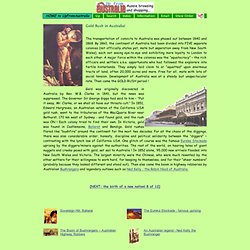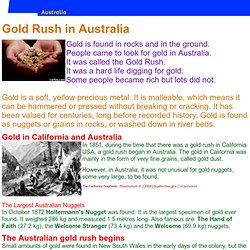

Ancient Australian History. After a long trek on foot or horseback by coach or dray from Sydney or Melbourne, new miners were thankful and excited when they reached the goldfields.

On the larger fields they saw hundreds or even thousands of tents clustered around creeks or near the site of earlier discoveries. There were horses and bullocks, wagons and carts and everywhere people bustling around, digging, panning, washing gravel, moving mounds of dirt or gently rocking their cradles from side to side. New miners soon realised, however, that the goldfields were not as attractive to live in as they looked from a distance. At Bendigo, for example, up to 40,000 people lived close together in tents.
They did not have enough water and their toilets were simply holes in the ground. Miners worked hard day after day and often could afford neither the time nor the money to buy good food. Australian Gold Rush: 1850. The bonanza in California was only the beginning.

An Australian named Edward Hammond Hargraves, who had been there, was certain that the same geological features were to be found in his own country. Returning on the boat from California late in 1850, he predicted that he would find gold within a week. 'There's no gold in the country you're going to and if there is, that darned Queen of yours won't let you touch it,' a fellow passenger told him. 'There's as much gold in the country I'm going to as there is in California,' snapped Hargraves, 'and Her Gracious Majesty the Queen, God bless her, will appoint me one of her Gold Commissioners.' Hargraves was right.
Find, mines, rewards, locations, South Australian Gold Rush. GoldRush. Discovery of Gold. Discovery of Gold - A Brief History In 1837, under pressure of a bad drought, Thomas Learmonth and a group of squatters explored the area to the north of their settlement near Geelong in search of better watered regions.

On this journey they reached and climbed Mt. Bonan Yowing (now Buninyong) and were thus the first to see the Ballarat area. In March 1838, two squatters, Yuille and Anderson, settled with their flocks on the banks of an area known as Black Swamp, now Lake Wendouree. During the next 13 years, shepherds and their flocks roamed in the area with Buninyong becoming the service township for the settlers. The discovery precipitated a great rush to the area which in turn resulted in the rapid growth of the new town of Ballarat. In that same year, 10,000,000 grams of gold were transported under police escort to the Melbourne Treasury. In the 1860's, when the shallow alluvial deposits began to run out, companies were formed to exploit the deep quartz lodes. Gold Rush in Australia!
The transportation of convicts to Australia was phased out between 1840 and 1868.

By 1860, the continent of Australia had been divided into FIVE separate colonies (not officially states yet, mate but seperation away from New South Wales), each not seeing eye-to-eye and exhibiting more loyalty to London to each other. A major force within the colonies was the “squatocracy” – the rich officers and settlers a.k.a. opportunists who had followed the explorers into fertile hinterlands. They simply laid claim to or “squatted” upon enormous tracts of land, often 20,000 acres and more.
Free for all, mate with lots of social tension. Development of Australia was at a steady but unspectacular rate. Gold! Gold Rush in Australia Gold is found in rocks and in the ground.

People came to look for gold in Australia. Gold rush history - Australia's Golden Outback. The Western Australian gold rush began with the first discovery of gold in the late 1890s.

News of the gold spread as fast as the region’s wildfires and soon gold prospectors were arriving to seek their fortune and set up gold rush towns in the dusty landscapes of the Kalgoorlie, Goldfields and Murchison regions. They came slowly at first, but as the finds grew so too did the population. Lonely clusters of tents and rough bough sheds were soon transformed into booming Western Australian gold rush towns.